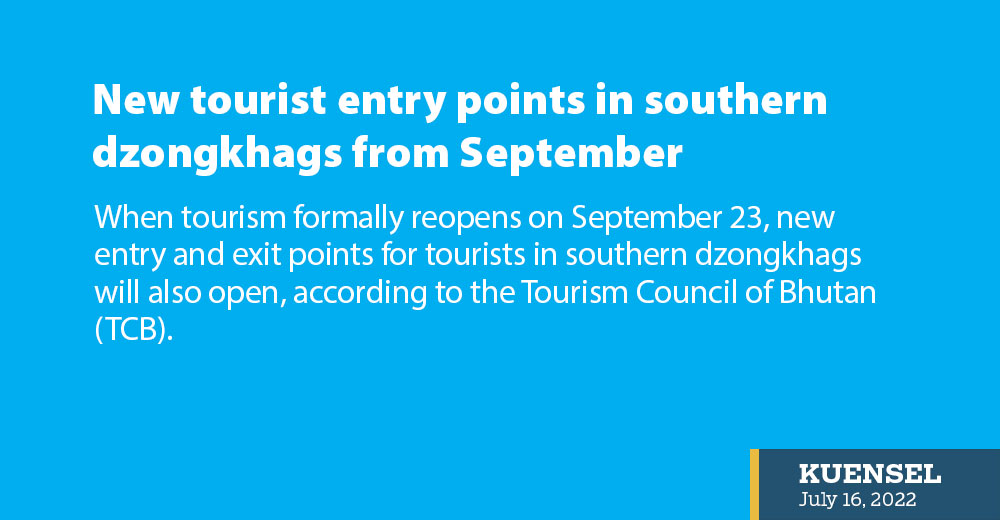MB Subba
When tourism formally reopens on September 23, new entry and exit points for tourists in southern dzongkhags will also open, according to the Tourism Council of Bhutan (TCB).
However, the director general of TCB, Dorji Dhradhul, said the required infrastructure and human resources should be put in place for the operation of the entry points for tourists.
“Efforts will be made to make the entry and exit points ready when the tourism formally opens,” he said.
The director general said that the rules and regulations of 2017 are being revised and adopted in line with the Tourism Levy Act 2022. “There are significant changes in the new Act.”
The business communities of southern and eastern dzongkhags were not sure whether the new entry and exit points for tourists will be opened with the implementation of the new tourism policy.
The government had agreed on a motion in the National Assembly to open entry and exit points at Samdrupjongkhar, Gelephu, Samtse, Nganglam and Panbang.
This was also one of the major election promises of the government.
Currently, Phuentsholing is the only entry point for tourists, which does not benefit eastern and southern dzongkhags.
Gangzur Minjey MP Kinga Penjor said that the number of tourists to eastern dzongkhags was expected to increase gradually with the improvement in infrastructures like roads and hotels. “I don’t expect tourists in big numbers as soon as the new entry and exit points are opened.”
Phuentshopelri MP Ganesh Ghimiray also informed the new entry and exit points would be opened as per the Parliament’s decision with the reopening of tourism.
“Tourism infrastructures are being developed and the opening of the entry point in Samtse would not only benefit the dzongkhag but also the neighbouring dzongkhags like Haa,” he said.
MP Ganesh Ghimiray said that Samtse town would be developed as a dzongkhag thromde and that the opening of the tourist entry point was important for the viability of the thromde.
A hotelier in Samdrupjongkhar said that the government should implement the parliament decision to improve the economy and bring about regional balance in tourism.
He said that given that eastern and southern dzongkhags do not have adequate high-end hotels, they needed to focus initially on regional tourists from the northeastern states of India.
One of the investors who have constructed a resort in Tsirang, Jiwan Siwakoti, said that opening the new gates for regional tourists would help the local economy significantly.
He said that it was not easy for regional tourists who enter from Phuentsholing to visit dzongkhags like Tsirang and Dagana. “Arguments that our region doesn’t have much to offer to tourists are not true.”
A former MP, Novin Darlami from Tsirang, said that it was high time to allow regional tourists to come through the new entry points cautiously for economic revival. “It should not benefit only a few businesses but all, including farmers.”
Some MPs and observers said that the opening of the new entry and exit points for tourists would bring about regional balance in tourism to some extent. However, they said that the southern and eastern regions were suitable for regional tourists in the initial phase.
Although the latest figures were not available, Paro had the highest number of international arrivals at 27.5 percent in 2017, followed by Thimphu and Punakha with 26.4 and 23.1 percent respectively.
Wangdue saw 7.9 percent arrivals while Bumthang received 5.1 percent of the arrivals.
The rest of the dzongkhags saw less than five percent of the total arrivals in the country. Pemagatshel, Tsirang, and Dagana did not receive any tourists in 2017.
More than 70 percent of tourists are regional, according to data with the TCB.


